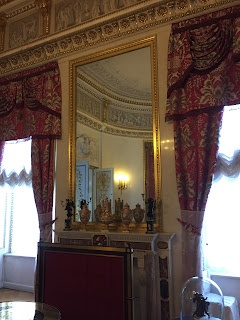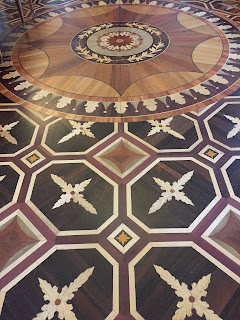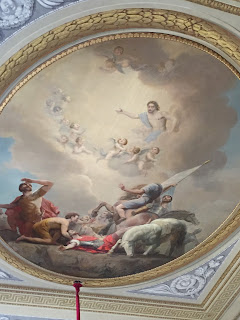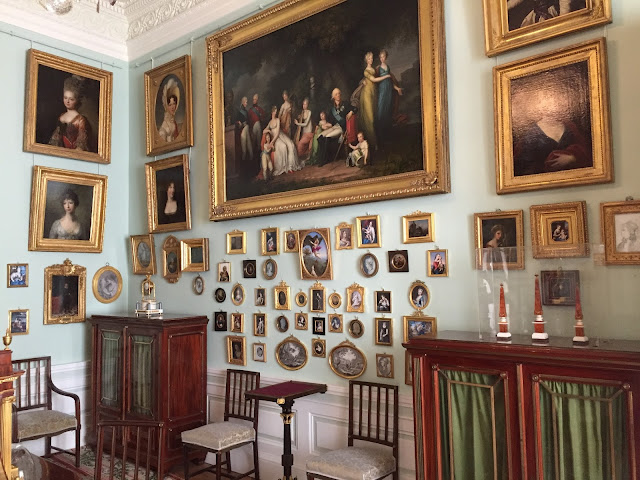127. St. Petersburg's suburban palaces #5 - Pavlovsk Palace
Pavlovsk Palace is one of St. Petersburg's less-commonly-visited suburban palaces, as well as the newest. It is named for Emperor Paul I ("Pavel"). His mother (Catherine the Great) gave the imperial hunting grounds on which it stands to Paul and his wife Maria Feodorovna as a gift in honor of the birth of their child, Alexander I, on 12 December 1777. This was years prior to Paul becoming Emperor, in 1796. Catherine's intention with this gift was that Paul build a house there and move out of her residence at Tsarkoye Selo - apparently they did not get along.
Work on the Palace began in 1780, with the foundation stone laid in 1782. Architects who worked on the building and its interiors include Charles Cameron, Vincenzo Brenna, and Andrey Voronikhin - truly an international effort. The Palace became the Emperor's official residence upon his ascension to the throne in 1796. After the death of the Dowager Empress Maria Feodorovna's in 1828 (Paul I had been assassinated back in 1801), a series of Grand Dukes lived in the Palace until 1915. The Bolsheviks seized the Palace during the Russian Revolution and turned it into a state museum in 1918.
During the Great Patriotic War, most of the art and furnishings were moved to safety. Like most of St. Petersburg's other suburban palaces, the Nazis destroyed most of the buildings during their occupation. An ambitious plan to restore the Palace began shortly after the end of the war, and within a few decades it looked as spectacular as it had in centuries past. Photographs are on display throughout the building that show what the spaces looked like immediately following the area's repatriation from the Nazis, before the Palace was restored. The destruction was not absolute, but the artists and craftsmen who spent years rebuilding the palace definitely had their work cut out for them. The original plans and drawings were fortunately available to help guide the restoration.
The town of Pavlosk is located just to the south of Pushkin, and in fact the city bus I took to Pavlosk drove through the center of Pushkin on the way there. Most passengers from St. Petersburg disembarked in front of Catherine Palace in Tsarkoye Selo, but several of us continued on to Pavlosk. I was the only passenger who disembarked in front of Pavlosk Palace itself. I enjoyed my visit. It was the third of Paul I's imperial residences that I visited in three weeks (after Gatchina Palace and the Priory Palace). He is definitely one of my favorite figures in Russian imperial history.
Highlights inside Pavlosk Palace include the Italian Hall, Rossi Library, Grecian Hall, State Bedroom, Picture Gallery, Throne Room, Cavalier's Hall, and White Dining Room (pictures below are labeled for these rooms). Beautiful paintings, clocks, vases, and antique furniture are liberally spread throughout the palace. Many of these priceless items were gifts from other European royalty at the end of the eighteenth century. As with other palaces in the area, the chandeliers and parquet floors in many of the rooms were also spectacular. One of the noteworthy paintings on the ground floor is a bit gimmicky but still quite fun - it's a cherub who appears to be aiming his arrow straight at you, no matter where you stand.
As you can see in the pictures, I had the Palace mostly to myself. A few tour groups were walking around, but for the most part they were a few rooms ahead of or behind me. I did see a bride and groom taking wedding portraits inside the Picture Gallery. I've encountered wedding photo shoots almost every day that I've been out sightseeing in central St. Petersburg, but this was the first time I've seen it in the suburbs, or inside a palace. Most of the crowds were actually outside, exploring the extensive gardens - which merit their own blog entry.
The Italian Hall:
The Rossi Library:
The Grecian Hall:

The State Bedroom:
The Picture Gallery:
The Throne Room:
The Cavalier's Hall:
Wedding photos in the Picture Gallery:
Living rooms on the ground floor, including Maria Feodorovna's private apartments:
The White Dining Room:
Work on the Palace began in 1780, with the foundation stone laid in 1782. Architects who worked on the building and its interiors include Charles Cameron, Vincenzo Brenna, and Andrey Voronikhin - truly an international effort. The Palace became the Emperor's official residence upon his ascension to the throne in 1796. After the death of the Dowager Empress Maria Feodorovna's in 1828 (Paul I had been assassinated back in 1801), a series of Grand Dukes lived in the Palace until 1915. The Bolsheviks seized the Palace during the Russian Revolution and turned it into a state museum in 1918.
During the Great Patriotic War, most of the art and furnishings were moved to safety. Like most of St. Petersburg's other suburban palaces, the Nazis destroyed most of the buildings during their occupation. An ambitious plan to restore the Palace began shortly after the end of the war, and within a few decades it looked as spectacular as it had in centuries past. Photographs are on display throughout the building that show what the spaces looked like immediately following the area's repatriation from the Nazis, before the Palace was restored. The destruction was not absolute, but the artists and craftsmen who spent years rebuilding the palace definitely had their work cut out for them. The original plans and drawings were fortunately available to help guide the restoration.
The town of Pavlosk is located just to the south of Pushkin, and in fact the city bus I took to Pavlosk drove through the center of Pushkin on the way there. Most passengers from St. Petersburg disembarked in front of Catherine Palace in Tsarkoye Selo, but several of us continued on to Pavlosk. I was the only passenger who disembarked in front of Pavlosk Palace itself. I enjoyed my visit. It was the third of Paul I's imperial residences that I visited in three weeks (after Gatchina Palace and the Priory Palace). He is definitely one of my favorite figures in Russian imperial history.
Highlights inside Pavlosk Palace include the Italian Hall, Rossi Library, Grecian Hall, State Bedroom, Picture Gallery, Throne Room, Cavalier's Hall, and White Dining Room (pictures below are labeled for these rooms). Beautiful paintings, clocks, vases, and antique furniture are liberally spread throughout the palace. Many of these priceless items were gifts from other European royalty at the end of the eighteenth century. As with other palaces in the area, the chandeliers and parquet floors in many of the rooms were also spectacular. One of the noteworthy paintings on the ground floor is a bit gimmicky but still quite fun - it's a cherub who appears to be aiming his arrow straight at you, no matter where you stand.
As you can see in the pictures, I had the Palace mostly to myself. A few tour groups were walking around, but for the most part they were a few rooms ahead of or behind me. I did see a bride and groom taking wedding portraits inside the Picture Gallery. I've encountered wedding photo shoots almost every day that I've been out sightseeing in central St. Petersburg, but this was the first time I've seen it in the suburbs, or inside a palace. Most of the crowds were actually outside, exploring the extensive gardens - which merit their own blog entry.
The Italian Hall:
The Rossi Library:
The Grecian Hall:

The State Bedroom:
The Picture Gallery:
The Throne Room:
The Cavalier's Hall:
Wedding photos in the Picture Gallery:
Living rooms on the ground floor, including Maria Feodorovna's private apartments:
The White Dining Room:





















































































































Comments
Post a Comment